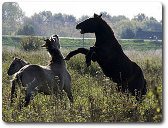The Wife of Bath's Prologue and Tale Contents
Birds, animals and insects
The chain of being
It is helpful to think about Chaucer's use of birds, animals and insects in The Wife of Bath's Prologue and Tale in the context of the medieval idea of the hierarchical chain of being. (See The world of Chaucer > Making sense of the intangible world > The chain of being.) In this scheme human beings occupied a position lower than God and angels but above that of birds and animals. They were seen as spiritual beings but, unlike angelic beings, were connected to physical bodies and subject to physical needs and sensations, like the animals and birds which were placed beneath them. So when Chaucer images humans as animals he is usually emphasising their animality, physical needs and desires, aspects of human nature which connect people to the ‘lower orders' of beings.
Some examples from the Wife's Prologue
Birds
- Luring the hawk, l. 415 - The Wife claims that no one can lure a hawk without a bait to entice it. She images herself as a predatory marriage partner who needs to be offered a reward to satisfy the demands of her sexually inadequate husband
- ‘pye' (magpie) l.456 – The magpie simile suggests the Wife's jolliness in her youth but it may have negative implications. The magpie is used as an image of passionate chatter in Chaucer's unflattering account of January, the elderly knight of The
 Merchant's Tale, in bed with his young wife, May
Merchant's Tale, in bed with his young wife, May - Two lines later the Wife uses the image of a Nightingale l.458 to suggest the beauty of her singing. On its own this would not suggest the animality of her sexual desire, but its context of drunkenness does – and also casts doubt on the validity of her claim!
Domesticated animals
- The Spaniel l.267 - The Wife claims that her husband had said that, whilst a desirable woman cannot be kept virtuous, an unattractive woman will leap on a man like a spaniel, - female desire is expressed with the image of an animal following instinct without restraint
- The Cat l. 350 - The Wife claims that her husband denies her luxurious clothing so that, like a singed cat, she will stay indoors. The sleek cat out caterwauling for a mate becomes an image of a woman in luxurious clothing on the loose
- The horse l.386 – The Wife claims that she can whine and bite like a horse, to get her way even
 when she is in the wrong. This suggests a large creature which is dangerous when it is out of control. This part of her prologue provides some of the strongest evidence that Chaucer is supporting rather than challenging negative stereotypes of women in The Wife of Bath's Prologue
when she is in the wrong. This suggests a large creature which is dangerous when it is out of control. This part of her prologue provides some of the strongest evidence that Chaucer is supporting rather than challenging negative stereotypes of women in The Wife of Bath's Prologue - In contrast to the image of the dangerous horse, the Wife offers a sheep as an image of meekness (l. 432) and suggests that her husband accepts her victory over him humbly.
Wild animals
Human beings out of control become dangerous animals.
- The Lion is associated with madness and dangerous lack of control and the Wife uses this image to describe her angered husbands. In l.429 the Wife's thwarted husband looked like a mad lion. Similarly, in l.794 the Wife gives an image of her husband's anger when she has torn some pages out of his book as being like a mad lion as he moves into action against her
- The Wife also images herself as a ‘leonesse' l.637. Here the emphasis is on power and stubbornness rather than madness
- According to her fifth husband, quoting the Apocrypha, a chiding Wife is a more terrible companion than a lion or a foul dragon l.776!
- In l. 376 the Wife recounts her husband's claim that a wife can destroy her husband as effectively as worms (caterpillars) destroy a tree. This is a powerful image of destruction linked in the passage to the notion of a self-perpetuating fire.
Some examples from the Wife's Tale
Birds
- In the embedded story of Midas' ears, a woman is again imaged as a talkative bird. Midas' wife talks to the water like a bittern booming in the marsh l. 973 and gives away the secret of her husband's ass's ears
- After his marriage to the Old Woman the Knight hides himself away, like an owl (l.1081), unseen by day.
Animals
- Women are again imaged as being like horses, in this instance as kicking back if clawed on a sore place (l. 940).
- The Knight, on the other hand, is described as manly because he does not stand silent like a beast l.1034 when his answer is required at court.
The power of the hand
Linked to the use of animals are images about their control by humans.
- l. 211 describes the Wife as having the old husbands wholly in her hand
- In l. 813 the Wife describes how her fifth husband eventually gave her the bridle in her hand. The Wife now has power, the means to direct and control her house and land, as well as her husband's tongue and hand (possibly his freedom to sign documents).
Investigating bird, animal and insect images
- Draw a diagram or chart that displays the animal images from the text
- Think about how you are going to locate the fierce and the meek, the small and the large, and to whom each image relates.
Recently Viewed
Scan and go

Scan on your mobile for direct link.